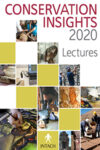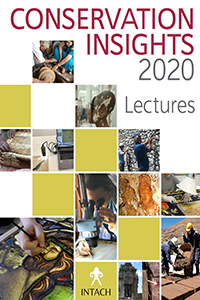Testing & Research Facility
INTACH Lime Research & Testing Centre, over a period of times, has developed many tests for scientific examination of lime, lime mortar, mural paintings etc. Presently Lime Research & Testing Centre is working on 35 tests related to historic lime and lime mortar. The Centre has adopted BIS standards as well as some other international standards. The Centre is committed to provide unmatched services in heritage conservation. Lime Research Testing Centre also provide training to architects, conservators, archaeological engineers, and heritage contractors.
| Sl.No. | Type of Test | Outcome | Usefulness |
| 1 | Visual Examination | Color of lime and state of Lime-like lumpy, powdery, | Purity of quick lime |
| 2 | Hydrochloric acid test | Gradation test of Quick Lime before slaking. | To know the class of Quick lime as A,B,C,D,E,F etc. |
| 3 | Ball test | Class of Lime after slaking | To know the class of Quick lime as A,B,C,D,E,F etc. |
| 4 | Impurity test | Quick Lime/ Impurity in lime | The presence of pure Calcitic lime( Cao) or Dolomitic lime( Cao & Mgo) |
| 5 | Plasticity test | Quick Lime/Lump formation | Plasticity of lime is carried out to know the workability |
| 6 | Volatile matter (100 0C) | % of volatile impurities at 100 0 C | % of moisture present in lime |
| 7 | Loss of ignition | % of volatile impurities of lime at 1000 0C | To determine moisture percentage in lime |
| 8 | Determination of Insoluble Residue in Dilute Acid and Alkali’ | % of Insoluble Residue in Dilute Acid and Alkali | Percentage of Insoluble Residue in Lime |
| 9 | ‘Determination of Insoluble Residue in Hydrochloric acid’ | % of Insoluble Residue in Hydrochloric acid | Percentage of Insoluble Residue in Lime |
| 10 | Determination of Silicon Dioxide | % of Silicon Dioxide | Percentage of Silicon Dioxide in Lime |
| 11 | Determination of Ferric Oxides | % of Ferric Oxides | Percentage of Ferric oxide in Lime |
| 12 | Determination of Aluminium Oxides | % of Aluminium Oxides | Percentage of Aluminium oxide in Lime |
| 13 | Determination of Calcium Oxide | % of Calcium Oxide | Percentage of Calcium oxide in Lime |
| 14 | Determination of Magnesium Oxide | % of Magnesium Oxide | Percentage of Magnesium Oxide in Lime |
| 15 | Workability Test | Amount of water | Determine the amount of water for the good workability of lime plaster |
| 16 | Slaking of lime in field and preparation of Putty | Slaking technique of quick lime | Get best quality slaked lime |
| 17 | Determination of residue on slaking of quick lime | Quick Lime/Impurity in lime | The presence of pure Calcitic lime( Cao) or Dolomitic lime( Cao & Mgo) |
| 18 | Determination of fineness of hydrated lime | Particle size of Impurities presence in lime | To know the fineness of hydrated lime |
Test of Lime Mortar
| Sl.No. | Type of Test | Outcome | Usefulness |
| 1 | Sampling | Samples collection from site, Photograph of building feature with a record shot. Photograph the mortar in situ before sampling. Note and record the color, texture of the plaster/mortar. Collection of at least two samples of the same type of mortar from different nearby locations, each between 25 and 50 grams. | Get samples from correct location like walls – outer, inner all the three layers as rough and fine plasters Ceiling ,Roof top ,Floor from corners and middle area, Samples from salt efflorescence area |
| 2 | Study of Physical properties | Documentation & photographic study of Plaster sample | Detail photo documentation during and after sampling in laboratory while understanding analysis |
| 3 | Elastic properties or strength of plaster surface, hardness and penetration resistance | Schmidt hammer, also known as a Swiss hammer or a rebound hammer. This instrument is used at site. Results are obtained in graphic form. | To study the nature of plaster in respect to good or dead plaster |
| 4 | Hardness of plaster by compression testing method | Fully computerized method for testing of new plaster samples used during restoration | To study the compression strength of new admixture used during / for restoration |
| 5 | Composition of plaster/mortar | Percentage of Lime and aggregate | Useful to know the percentage of slaked lime and type of aggregates during the preparation of admixture |
| 6 | Microscopic study | Different type of aggregates in plaster | Get an idea about the type of aggregate. |
| 7 | Grain Size Analysis | Particle size distribution by Sieve analysis method | Different size of aggregates which play vital role in preparation of admixture |
| 8 | Study of soluble salt | Presence of different soluble salt deteriorating the plaster | To check the points of capillary action by providing barrier of damp proofing material |
| 9 | Carbonation test | Setting of lime mortar, plaster /Carbonation status of newly applied lime plaster | This tells about the completion of hardness which may occur after years; as per literature available complete carbonation takes many years. |
| 10 | Absorption test by Karsten Tube method | Absorption of any liquid on stone and lime plaster surface | It detects absorption level of water, solvent etc on stone surface/brick or lime plaster surface. Data can be calculated in relation of time. |
| 11 | Water absorption by Total immersion | Absorption of any liquid on stone and lime plaster surface | It detects absorption level of water |
| 12 | Water absorption by Capillary Action | Absorption of any liquid on stone and lime plaster surface | It detects absorption level of water by capillary Action |
| 13 | pH of Lime Plaster | pH of lime Plaster | It detects the pH of lime Plaster |
| 14 | Workability Test | Evaporation rate | Indirect study of porosity in plaster |
| 15 | Artificial weathering | Artificial ageing effect | Half-life period of plaster |
| 16 | Natural weathering | Natural ageing effect | Half-life period of plaster |
| 17 | Movement of Salt | % of Salt absorption by lime Mortar | Total absorption of salt by Capillary action |
| 18 | Setting Time by Vicat apparatus | Setting property of lime Plaster | Get approx. timing of setting of plaster although the complete hardness comes due to evaporation of water and carbonation from plaster after long duration may be after many days, month or years depending on the thickness of plaster and the surrounding atmospheric condition of the building. |











